Action Sports & Energy Drinks
Outside industry sponsorship has long been the Holy Grail for promoters and race teams, and a decade back, the sizeable injection of energy drink money certainly came at a fortuitous time for a motorcycle racing industry knocked flat by the GFC.
But is energy drink sponsorship healthy for the sport’s long-term prospects, or its participants? Have race teams or promoters been assuming the money will be around forever? Why did Rockstar disappear so suddenly from the race scene here in Australia? Where are the other big energy drink players? And is there a risk this ‘sugar money’ will be subjected to regulation, in the same way alcohol and tobacco sponsorship was?
Back in 2013, in an article first published in Transmoto’s printed magazine (in Issue #31), we posed these very questions. And we reckon they’re questions well worth reflecting on now…
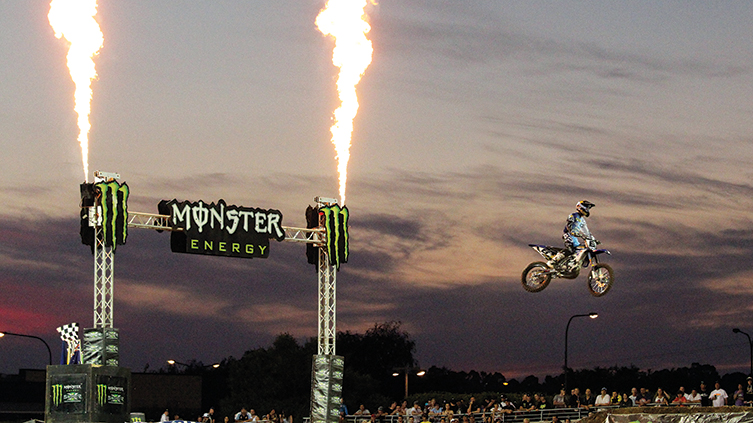
Energy drink brands have tipped big bucks into Australian motocross and supercross in recent years. But are promoters and teams relying too heavily on this sponsorship? Can the sport survive without it? And are these sweet dollars here to stay? We investigate…
For the past decade, the AMA motocross and supercross series have doubled as marketing battlegrounds for energy drink brands. Think back … you had BooKoo, Monster, Rockstar, Red Bull, SoBe No Fear, Unbound, Hansen’s, Skaterade, Fusion, DNA, Coca Cola’s fleeting Full Throttle, and a refrigerator full of others who’ve since disappeared. By the time energy drink sponsorship found its way into Australian MX/SX pit paddocks, there’d been an inevitable shakeout, leaving only Red Bull, Monster and Rockstar. And since 2008, it’s been primarily Rockstar and Monster who’ve squabbled over the sport in Australia.
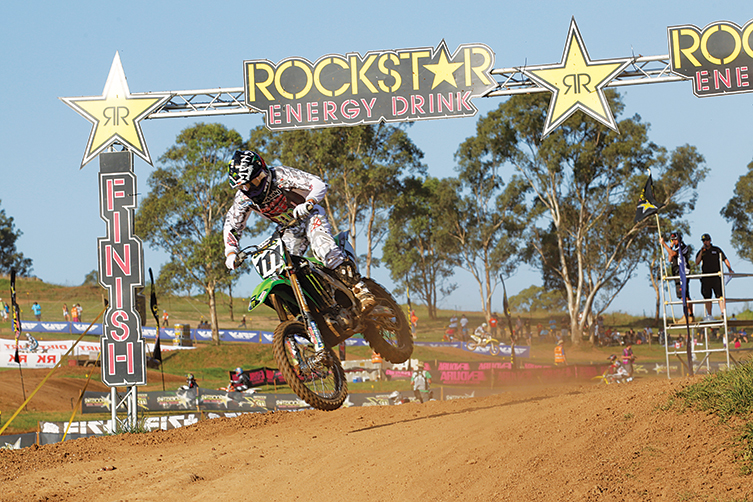
Despite that concentration of brands, no one’s been complaining. And why would they? Outside-industry sponsorship has always been the Holy Grail for promoters and race teams, and the sizeable injection of energy drink sponsorship certainly came at a fortuitous time for an industry knocked flat by the GFC. In fact, you could argue that energy drink money underpinned the very existence of our national race series for several years. From the outside, this marriage of energy drink money and motocross was the perfect storm; a sublimely timed partnership of two products that targeted the same young, edgy and thoroughly impressionable Gen-Y market.
But is energy drink sponsorship healthy for the sport’s long-term prospects? Have race teams or promoters been assuming the money will be around forever? Why did Rockstar disappear so suddenly? Where are the other big energy drink players? And is there a risk this ‘sugar money’ will be subjected to regulation, in the same way alcohol and tobacco sponsorship was?
With these sorts of questions starting to become more prevalent in industry circles and pit paddocks, we thought it was time to put energy into getting some answers…
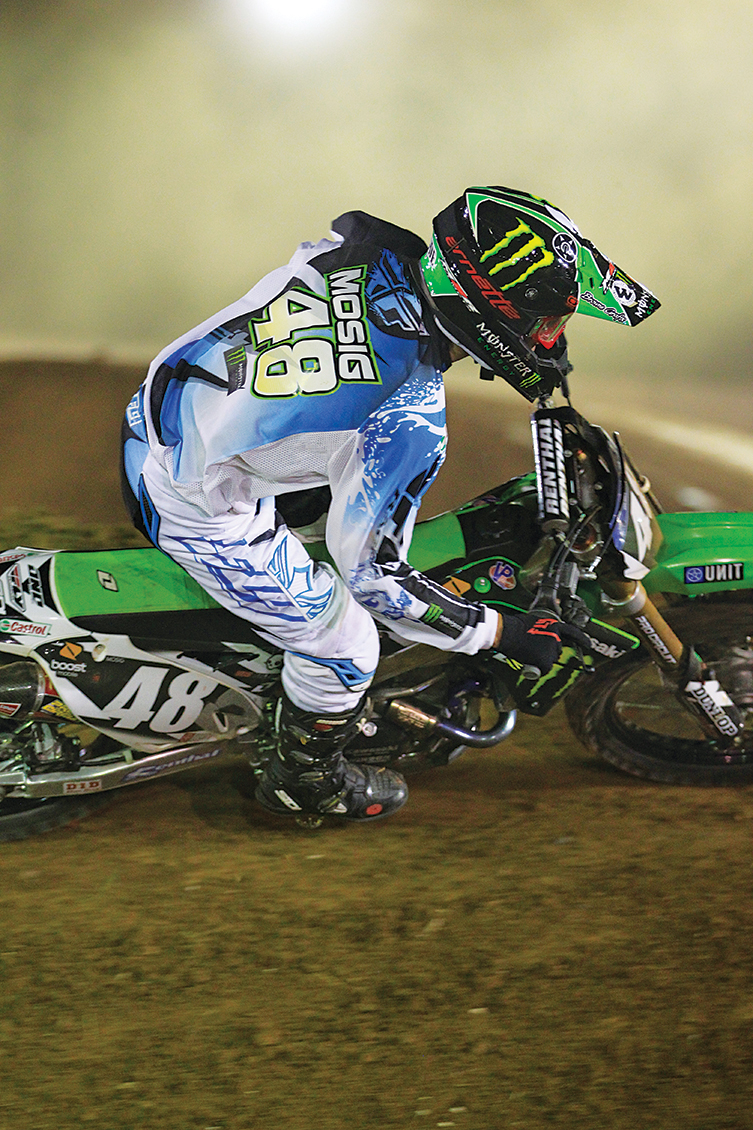
WHY SPONSOR MOTOCROSS & SUPERCROSS?
You don’t need a marketing degree to understand why energy drink brands have targeted the high-energy sport of motocross and supercross and its impressionable 15 to 25-year-old demographic. But are there other elements that make the sport a particularly attractive investment for them?
According to Monster’s Adrian Hunter, “Motocross people are extremely loyal. They look at the brands who get behind their sport, and they stick with them. Plus motocross and supercross is where we really established ourselves. The sport is part of our heritage and brand DNA. If we only had the opportunity to sponsor one thing in Australia, it would be MX and SX.”
Rockstar’s Mike Kelso views it similarly: “Motocross is where Rockstar started 12 years ago and the sport represents a major share of our marketing investment,” he says. “It’s a sport where fans are very passionate, and Rockstar’s investment in the Australian Super X and MX Nats series since 2008 was a good opportunity in an avenue we were familiar with.”
Compared to America, energy drink sponsorship of Australian MX and SX is a more recent phenomenon for the simple reason that Rockstar and Monster only launched here in 2008 and 2010, respectively. And MX/SX was a key part of both brands’ launch strategy.
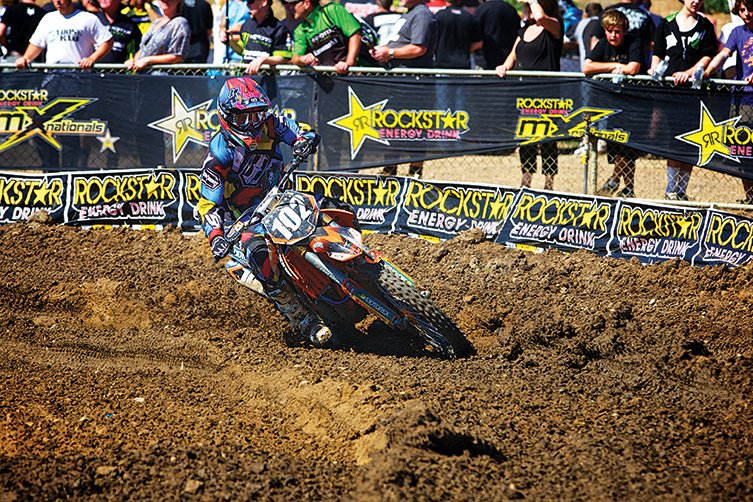
“When the Super X series started in 2008, Rockstar was just launching in Australia, so the timing was perfect,” explains General Manager of the Australasian Super X series, Mal Peter. “They were all about marketing their brand in edgy, extreme-style sports. Plus Chad Reed had just signed on with the Rockstar Suzuki team and he came back from America to race the series. While the population of Australia is not huge, energy drink sales from a per capita point of view is very high. So we’re an important market for these companies, which is why they’re all out here now.”
CDR Yamaha’s Craig Dack also acknowledges the fit of the fan base. “The sport’s demographic is broad enough to include impressionable teenagers, high disposable income 30-year-olds and young families,” Dack says. But he reckons the appeal has a lot to do with bang for buck and promotional freedoms, too. “For a few hundred grand, energy drink brands can get naming-rights to a national MX or SX series, which is half of what signage on the bonnet of a V8 Supercar might cost,” argues Dack. “Plus there are very few restrictions about what sponsors can and can’t do. For instance, in most NRL and AFL stadiums, someone will have the pouring rights to those venues, meaning nothing else can be sampled at events held there. In MX and SX, it’s more casual and the energy drink companies can access the consumer directly. And that’s what they value most.”
WEM’s Kevin Williams points out that outside-industry sponsorship for the MX Nats was around before the arrival of the energy drink brands. “We had Maxxis as the naming right-sponsor from 2001 to 2004, and Nokia from 2005 to 2007,” Williams recalls. “Everyone was aware of the growing opportunities with the energy drink companies. Red Bull was starting to get more heavily involved in motorsport, and a large number of energy drink companies were supporting riders, teams and series in the USA. So it was inevitable to some degree as it became increasingly clear that extreme sports – and motocross and supercross, in particular – were of interest to these companies. But it was more a case of good timing than us pursuing those dollars. The MX Nats had just come to the end of the Nokia program – who headed into music – and Rockstar was looking
to get into the Australian market at that same time.”
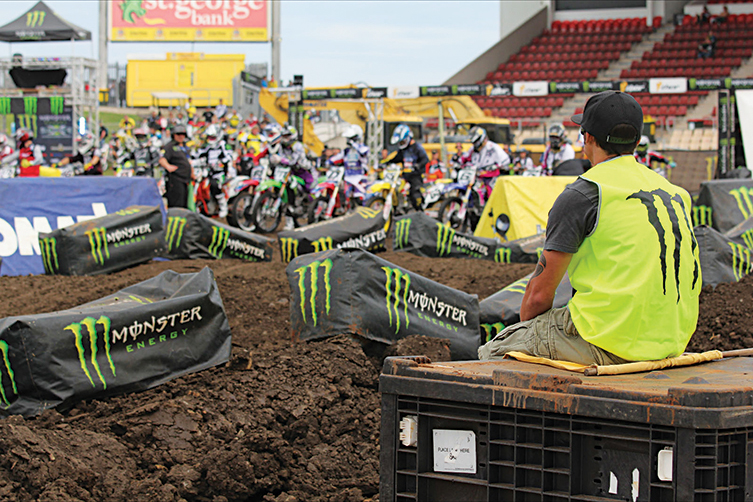
BUT ARE THERE ANY DOWNSIDES TO ENERGY DRINK MONEY?
Having attracted sponsorship from Peter Jackson, Miller Beer, Nokia, Boost Mobile and Rockstar as naming-rights sponsors for his race team over the past 20 years, CDR’s Craig Dack has done his time in boardrooms in search of corporate sponsorship. And he believes the appearance of energy drink money was, in some ways, a lifeline to both the sport and his team.
“Attracting corporate sponsorship is becoming increasingly difficult and there are a few reasons for it,” Dack explains. “First, there’s no longer as much ‘warm and fuzzy’ money from companies whose marketing guy loved motocross. These days, every dollar has to be quantified. Meanwhile, the costs associated with running a competitive race team have escalated. I’m fortunate that, because of my 30-year relationship with Yamaha, there’s a solid two-way loyalty. At the moment, Yamaha is footing a lot of the bill. So when Yamaha – like all the other manufacturers – made some serious cutbacks during the GFC, the Rockstar sponsorship allowed me to retain the same budget. In other words, it’s difficult for me to see much downside from energy drink investment – aside from the fact that it can also disappear very quickly!”
Suzuki also had Rockstar as the team’s title sponsor in 2010 and 2011 but, as Team Manager Jay Foreman points out, it doesn’t come without strings attached. “As sponsors go, energy drinks tend to be very demanding in terms of logo frequency and positioning. And then there’s the promo girls and uniforms. Don’t get me wrong; that money was great while it was there. But I’ve come to realise that money comes and goes as these outside-industry brands chase various marketing opportunities as they arise.”Dack agrees. “As Red Bull’s investment is scarce in Australian MX and SX, sponsorship has been dominated by Rockstar and Monster. They’re both American-owned companies who tend to be aggressive in their marketing approach. And they’re demanding with what they expect you to deliver for them.”
Monster Energy Kawasaki’s Team Manager, Troy Carroll, has a slightly different take. “If someone came to me tomorrow and offered me half a million bucks to paint our truck pink, I’d do it,” TC says with a laugh. “Obviously I’m joking, but the point is that servicing big-dollar sponsorship is important for long-term relationships. You’ve got to go where the money is. That said, in Australia, the manufacturers are still the major sponsors for race teams in terms of product, parts and money.”
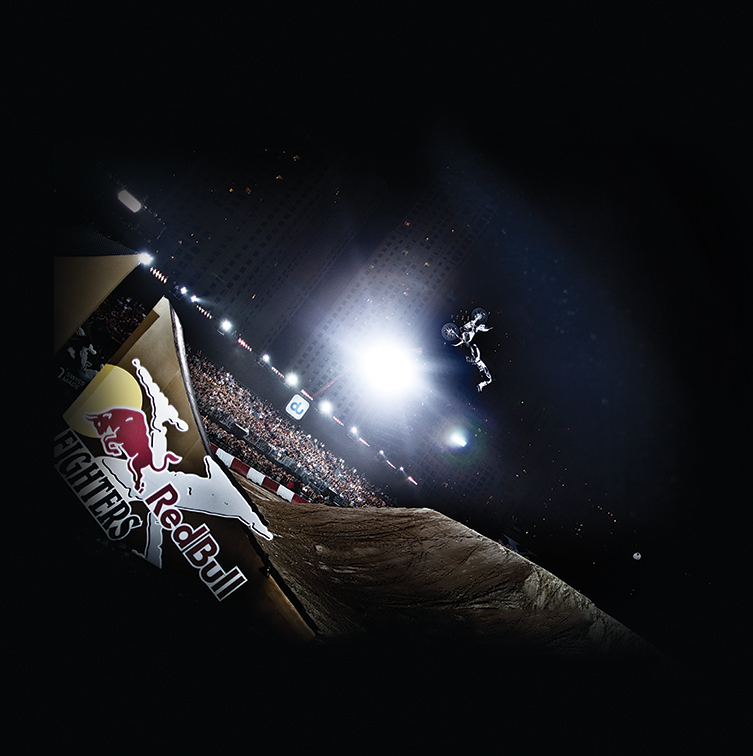
WHAT SORT OF MONEY ARE WE TALKING ABOUT HERE?
“I can’t divulge specific numbers behind Rockstar’s or Monster’s naming-rights sponsorships for the MX Nats,” says WEM’s Kevin Williams. “What I can say is that the level of Rockstar’s initial sponsorship represented a significant increase over the previous naming-rights sponsors – Maxxis and Nokia. But that was largely because the money back then was specifically supporting the series’ TV broadcast.” Super X’s Mal Peter was happier to talk turkey. “The three-year deal that Super X struck with Monster Energy was for more than $2 million,” explains Peter. “With Monster being the title sponsor of the same series in the USA (and because Chad Reed had just signed with Team Monster Kawasaki in the States), Super X made a lot of sense for Monster in Australia. The sponsorship didn’t specifically come with an amount allocated to the television production, but it certainly helped Super X commit to a TV broadcast schedule ahead of the series, as it costs somewhere in the vicinity of $100,000 per round for live TV.”Monster’s Adrian Hunter concedes that the sort of money energy drink companies tip in is significantly more than chump change. “In total, we spend in the vicinity of $5 to $7 million per year for athletes, events and activation in Australia,” Hunter says. “And our investment into motocross in Australia – meaning the MX Nats series, the Monster Energy Kawasaki team and the riders – is the biggest component of that spend. That’s not only from a cash perspective, but also in terms of our promotional activities. We’ll have sales guys on the ground two weeks before an event takes place in a certain town; to give away tickets and make sure our presence is strong. With sponsorships like the MX Nats, we’re talking ballpark numbers of between $100,000 and $300,000, depending on what sort of activations are involved. Generally speaking, for every dollar invested into a sponsorship, we will spend at least that amount again on
activation – or ‘leveraging’ that sponsorship – to get bang for our buck. Motocross is where we really established ourselves as a brand, which is why it’s so important we work with Williams Event Management and take the MX Nats to the next level. Yes, promoters get money from Monster. But we also make them work hard for it.”
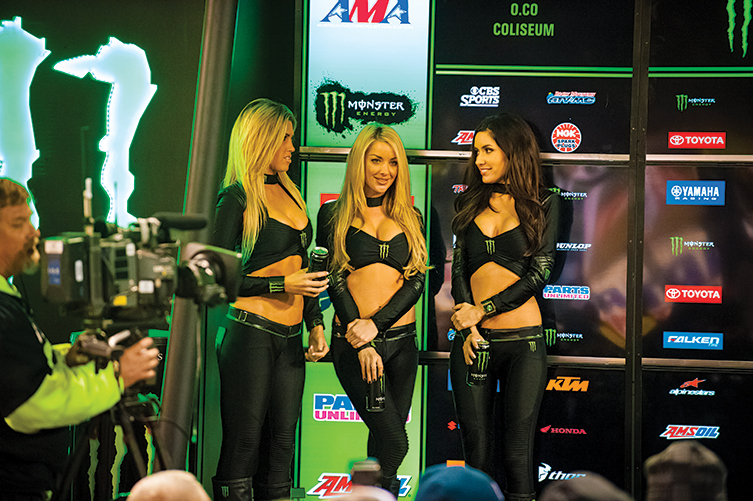
LEVERAGING THE SPONSORSHIP…
Aside from the cold hard cash, there other tangible benefits from energy drink brands being involved in the sport. As Super X’s Mal Peter explains, “The reality is that SX and MX are still niche, not mainstream, products in the greater scheme of sport. Energy drink sponsorship allows promoters to get into mass convenience stores, so these sponsorships are hugely beneficial for the series from a marketing and branding point of view. You couldn’t otherwise buy that access; the convenience stores simply wouldn’t entertain the idea.”
WEM’s Kevin Williams is on the same page. “While the cash injection from Monster is not as large as Rockstar’s in previous years, ”Williams explains, “their investment in leveraging that spend by promoting the series through their own initiatives amounts to considerably more value. Monster’s activation team visits all the regions where we race two weeks prior; to create point-of-sale opportunities in venues we can’t get to. The local service station, for instance, is used for ticket giveaways and to promote the event and its riders.” Not only that. As Monster Kawasaki’s Troy Carroll points out, “Energy drink sponsorship also increases the likelihood that we can get American athletes to race in an Australian series, without having a problem with conflicting sponsors. When Monster sponsored the Super X, the deal allowed them to entice Josh Hansen to race the series. Hansen was a huge drawcard, so it was good for everyone concerned.”
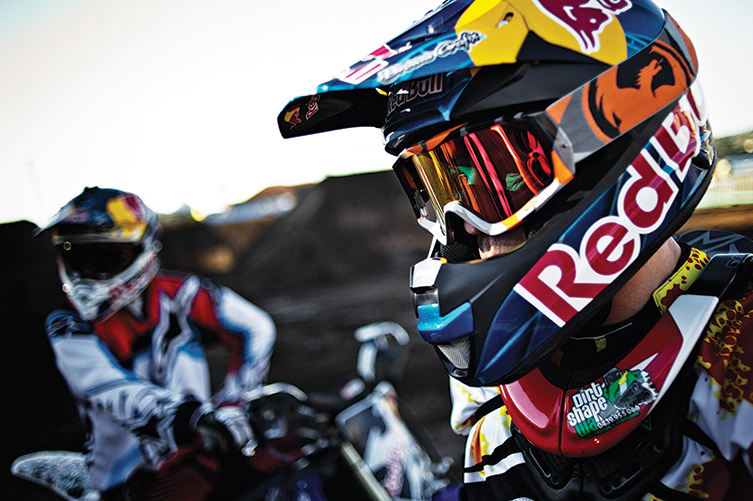
WHERE ARE THE OTHER ENERGY DRINK BRANDS?
Admittedly, there’s been a massive rationalising of energy drink brands in recent years. But if the sport provides the ideal marketing platform for energy drinks, then why is it that only two or three brands are now involved?
“I think the other energy drink brands have seen how committed Monster is to the sport,” concludes Monster’s Adrian Hunter. “So for V and Mother to get involved at this stage would only look like they’re following Monster. It’s also got to do with brand identity. As a brand, V is for everyday mums and dads and truck drivers – kind of the Coke of the energy drink category. And Red Bull don’t follow; they like to be innovative and come up with their own events.”CDR’s Craig Dack recounts an incident from the Super X series that sounds alarm bells: “Back in the Monster-sponsored Super X, we had a situation where promoters were saying that our riders couldn’t get up on the podium with their Rockstar bottles. Which is crazy, so we did it anyway. So I think promoters need to be mindful that that sort of behaviour isn’t conducive to attracting other energy drink brands. The fact Monster has now become so powerful in the sport in Australia can create a barrier to entry for competing brands.”
Rockstar’s Mike Kelso agrees: “There are some interesting cultural differences between the way the various energy drink brands approach their sponsorship. I look at what Monster does around the world and I think a lot of it is often over-done. It’s over-branding. Rockstar began as a family business with a $50,000 start-up investment 12 years ago, so we tend to do things a little more subtly. We promote the brand via athlete and team sponsorship, rather than kind of ambushing a series and trying to control it.”
Not surprisingly, Monster’s Adrian Hunter sees things differently. “I believe the fundamental reason is that Monster has succeeded in the sport is that it’s a very inclusive brand, whereas Red Bull is very exclusive. Red Bull has the 27 to 40-year-old suit and tie bracket pretty much sewn up, but we’ve done a good job of fast becoming an aspirational brand for the youth. Honestly, I would love the other energy brands to step into motocross and supercross in Australia, purely for the reason that it would be great for more teams to have that sponsorship money. If Rockstar, Mother and V all put $300,000 into the sport, then we’d have an absolutely fantastic series with riders from Europe and America lured over here to race. I have my own selfish reasons to be the title sponsor for the MX Nats, but it’d be nice to see other brands in there to help grow the sport.”
Monster Kawasaki’s Troy Carroll takes the same view: “It was actually disappointing for us to see that Rockstar pulled out of sponsoring Australian series and teams, because I think energy drinks have been very positive for the sport, and vice versa. I’d like to see companies like Red Bull and Muscle Milk get involved, too. Competition’s healthy.”
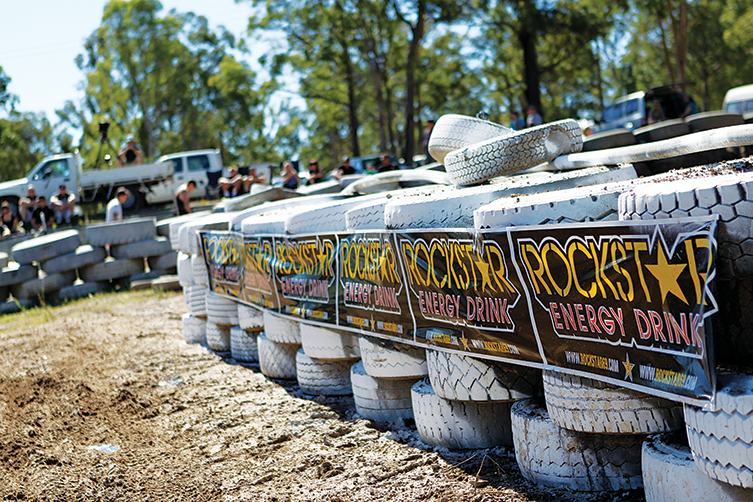
SO WHAT HAPPENED TO ROCKSTAR IN OZ?
As recently as 2011, Rockstar was the naming-rights sponsor of the MX Nats, and both Yamaha and Suzuki race teams. By the time the 2012 race season kicked off, the brand was nowhere to be seen. So what happened to Rockstar’s sizeable investment into the sport – from riders to teams to series? “Rockstar USA put deals in place for Kevin Williams’ MX Nats series and Craig Dack’s CDR Yamaha team,” explains Rockstar’s Mike Kelso. “Both teams of people were great to work with on all levels. It’s unfortunate that the marketplace didn’t give us the return on the investment, and to keep our P&L in line we needed to make some changes to the way we distributed Rockstar’s product in Australia. And that affected our marketing strategies. We loved the sport and the partners we had; it was just a financial reality that we couldn’t remain part of it.” Rockstar’s decision to pare back their sponsorship wasn’t isolated to Australia. As Team Suzuki’s Jay Foreman explains, “Rockstar’s naming-rights deal with us for 2010 and ’11 was linked directly to American Suzuki’s deal with Rockstar. So when the US deal fell over, ours did along with it. As good as big-dollar sponsorship from the energy companies is, you can easily spend half of it servicing that sponsorship and promoting their product.”
International decision or otherwise, Rockstar’s disappearance didn’t go down well with CDR’s Craig Dack, and the experience reinforced the value of sponsor loyalty for him. “Losing Rockstar’s sponsorship immediately before the 2012 season was one of the dirtiest things that’s ever happened to me as a team manager,” says Dack. “But this is what happens with outside-industry sponsors. They come and go when they decide to take a different direction with their marketing strategy. That’s what happened when we lost the Nokia sponsorship; they decided to focus on the music market. All CDR’s industry sponsors, however, are the same brands that sponsored me 25 years ago when I raced. They’re there through thick and thin; win, lose or draw.”
Kevin Williams is more philosophical about Rockstar plight in Oz. “I don’t think Rockstar’s initially had the resources and infrastructure in Australia to take full advantage of the partnership with the MX Nats in 2008,” reflects Williams. “We reignited the partnership in 2010 when they got their new distribution structure in place, but at the end of the 2011 season, Rockstar began to focus on other promotional opportunities. That’s when WEM began speaking with Monster, who’d quickly established a solid footing in the Australian market. I had a relationship with the Monster guys in my role as Race Director for the Super X, and when that series was discontinued, Monster saw the opportunity to leverage off the MX Nats.” “To their credit, Rockstar came into SX and MX prior to Monster Energy launching in Australia,” says Adrian Hunter. “But they simply didn’t have the manpower to service the investment. I think it was a quick dollar for the MX Nats and for the Yamaha and Suzuki race teams, who really didn’t have to work too hard for it. And consequently, it didn’t grow the sport here.”
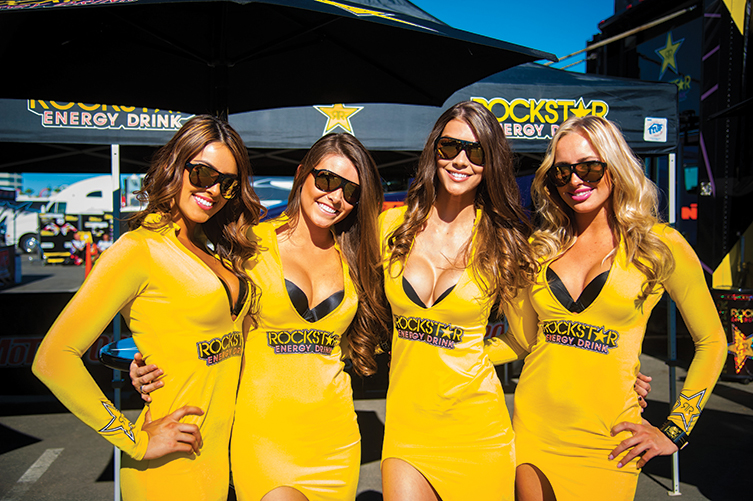
IS THERE TOO BIG A RELIANCE ON THIS SUGAR MONEY?
The first thing any business analyst will tell you is to not become overly dependent on one source of income. Did Australian teams and promoters fall into that trap? Is there a risk the energy drink sponsorship will dry up as fast as it first appeared? “From a business model perspective, you could say it’s a risk for the promoters,” concedes Monster’s Adrian Hunter. “But we have no plans to disappear. The energy drink segment is seeing double-digit growth, while the traditional soft drink market is growing between zero and five percent. So I don’t see energy drink sponsorship drying up in the next five years. In fact, I believe that it’s likely to become stronger. Any deals Monster does are structured so we all benefit from helping elevate attendance levels. The more attendance, the more visibility we get as a brand. ”Rockstar’s Mike Kelso isn’t so sure. “Rockstar is no longer involved with the MX and SX scene in Australia,” explains Kelso, “but I doubt if you’ll see Monster continue to dump the kind of money into the sport in the years ahead.
I believe they’ve already downsized much of what they’re doing in this past year and I’d anticipate the trend will continue.”
Having seen outside-industry sponsorship come and go, CDR Yamaha’s Craig Dack is also guarded, if not skeptical. “I know they say they’ll be around for some time, and I don’t doubt their sincerity,” says Dack. “But youth brands with aggressive marketing strategies can change their focus very quickly. So, yes, there has been too big a reliance on energy drink money, but only because we’ve had to! Ten years ago when I worked in America, the major teams had sponsors knocking on their door all the time, looking to hang branding off their bikes and riders. That no longer happens.”
Of course, this isn’t the first time that WEM’s Kevin Williams has considered how deep the energy drink sponsorship well is. “I fully understand there’s a risk that energy drink sponsorship won’t be around forever, or not on the same scale as it currently is,” Williams says. “Whilst we have a great relationship with Monster, WEM is not relying solely on that to ensure the stability of the series and the sport. I really think ‘sponsorship’ is a word we should get rid of. To me, sponsorship is a goodwill gesture in good times. Everybody needs to look at any sponsor’s spend as marketing or branding, which implies there needs to be a return on that investment. These days, offering value for sponsors is about much more than signage on a track. We all need to be innovative to justify any spend.”
Maybe it’s wishful thinking, but Monster Kawasaki’s Troy Carroll has more faith in the longevity of the energy drink money in the sport. “I’ve been around since the days Craig Dack’s team had big sponsorship from Miller Beer and Peter Jackson tobacco money, before the telecommunications companies – such as Nokia, Boost and OneTel – got into the sport,” Carroll explains. “So I’m aware that outside-industry money comes and goes in cycles. But I see the energy drink money being around for a lot longer because it’s become so much more synonymous with the sport around the world in just a few short years.”
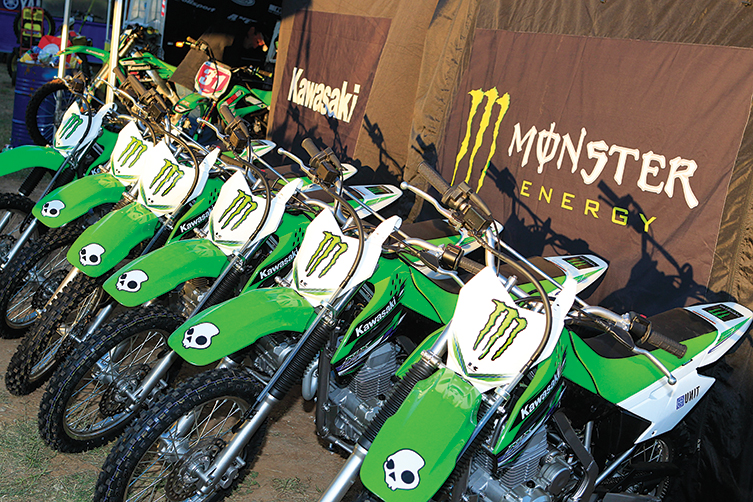
ARE THE ANALOGIES WITH THE DAYS OF ALCOHOL & TOBACCO SPONSORSHIP FAIR?
According to recent – and predictably sensational – reports on Today Tonight and A Current Affair, “sugar is the new fat”. It’s argued that the refined sugars found in fizzy drinks create dire health risks – such as obesity, diabetes and hyperactivity disorder. Given that these drinks are heavily marketed via action sports and motorsport, it’s prompted comparisons between current-day energy drink sponsorship and the golden years of tobacco and alcohol money. So, is energy drink sponsorship living on borrowed time?
Rockstar’s Mike Kelso dismisses the talk. “Honestly, I don’t think people can legitimately group energy drinks in with tobacco or alcohol,” he says. “If authorities have concerns about levels of sugar or caffeine, why don’t they look at Coca Cola or your local Starbucks? We’re in compliance with every regulation around the world, so I think any talk of regulation on energy drinks or their sponsorship spend is little more than hype. Yes, there’s a parallel with alcohol and tobacco, but only in the sense that energy drinks is a category that has invested heavily into motorsport sponsorship programs.”
Monster’s Adrian Hunter sees things much the same way: “At the end of the day, people are going to get fat. And get lung cancer. And die. Like alcohol or tobacco, you’re likely to have health issues if you’re abusing the substance. Our recommendation for Monster is one drink per day. Per 100ml, Monster has less caffeine than a cup of coffee and less sugar than many soft drinks. Monster is monitored by the Australian Health Association and we adhere to those laws. So if there’s going to be legislation over the intake of these substances, energy drinks shouldn’t be the first in line.”
Yes, you’d expect those sorts of comments from the guys whose job it is to sell energy drinks. But what about the promoters who take their money and help market the stuff?
“I’ve been asked about whether we should be taking energy drink money, and my answer to that is quite simple,” says Kevin Williams. “These companies are looking for marketing opportunities and the MX Nationals is regarded as an effective advertising portal. Their products are legal to sell and drink. It’s like anything; you can’t legislate against stupidity. That said, we’re upfront with our sampling partners to ensure the product is not handed out directly to young kids. They only get it with their parent’s consent.”
Super X’s Mal Peter takes a similarly matter-of-fact view, but doesn’t believe energy drinks will remain exempt from restrictions forever. “As a promoter, our obligation is to put on a series and make money, and ensure we work within the constraints of the law,” explains Peter. “Energy drinks are a legally advertised and sold product. If there’s no legal restriction on the sale of a product, it’s very hard to impose restrictions on advertising and marketing of those products. For tobacco and alcohol, changes in legislation meant promoters had to adapt according. Currently, there are no such restrictions on the sale of energy drinks, but I think there may be in the future. There are worse things out there than energy drinks, but then the wowsers have to have something to complain about.”
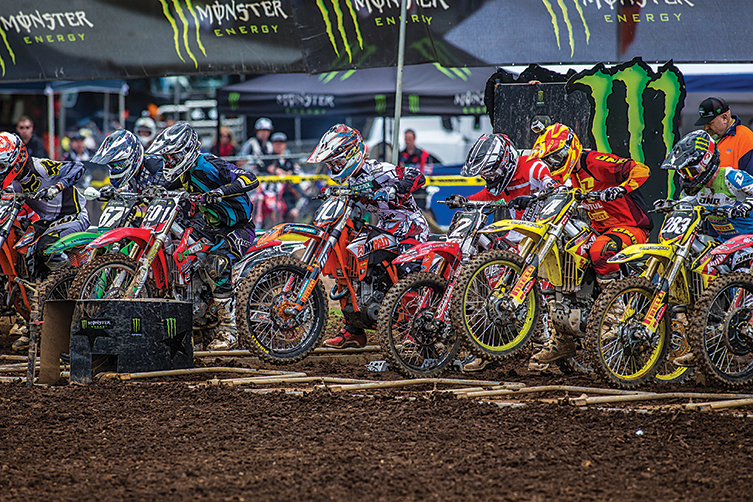
ENERGY DRINKS STATS…
- Red Bull, in effect, created the energy drink niche in the 1980s when Dietrich Mateschitz (then a marketing director for a toothpaste operation called Blendax) was in Thailand and noticed that long-haul motorists used energy drinks to keep them alert. Two years later, Mateschitz began marketing a new drink that contained an energy-boosting ingredient called taurine, and called it Red Bull.
- The energy drink market in Australia is currently worth an estimated $850 million annually.
- Over the past four to five years, the category has experienced year-on-year growth of between 12 and 17%.
- Estimates say the category will be worth $1 billion by the end of 2014.
- Red Bull remains the market-share leader in a majority of European countries.
- Monster is the market-share leader in the USA and another dozen countries around the world.
- In Australia, V is the market-share leader. It’s followed by (in order) Red Bull, Mother, Monster and Rockstar. In terms of volume, V has about 37% of the Australian market, followed closely by Red Bull. In dollar terms, however, Red Bull is number one in Australia.
- In Australia, V and Rockstar are distributed by Frucor Beverages. Red Bull is distributed by themselves. Mother is distributed by Coca Cola. Monster is distributed by Schweppes.
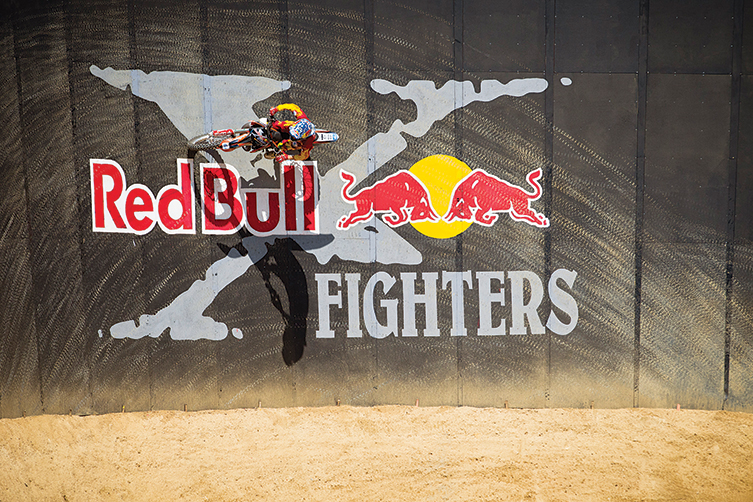
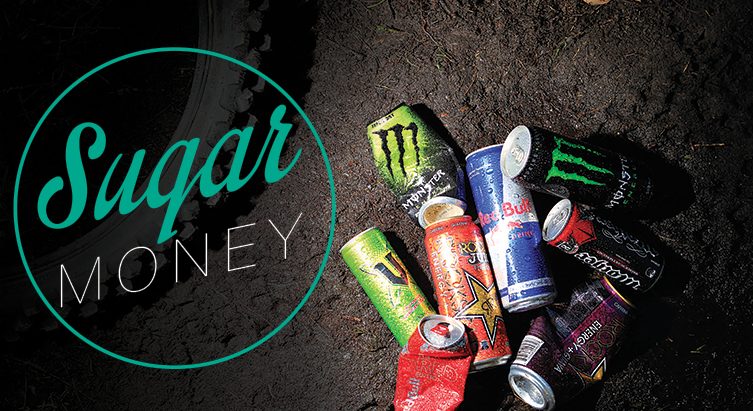







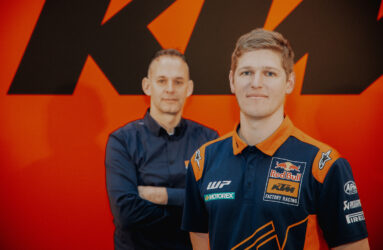
Be the first to comment...